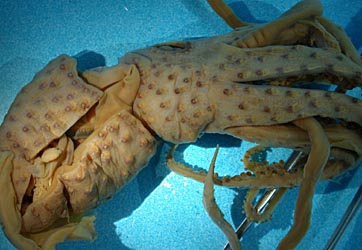Histioteuthis inermis
Richard E. Young and Michael VecchioneCharacteristics
- Photophores
- Basal Row with 10 photophores and without sawteeth.
- Apparently no separate group of compound arm-tip photophores is present.
- Tentacle club
- Large medial suckers about 2X diameter of marginal suckers.
- Large medial suckers about 2X diameter of marginal suckers.
- Suckers
- Sucker rings on arms IV smooth.
- Rings on enlarged median suckers of manus with 20-27 narrow, conical teeth around entire margin.
Comments
More information on the description of Histioteuthis inermis can be found here.Species of the celetaria-group are characterized by:
- Head photophores:
- Type 1b pattern on head.
- Basal Row of head with 9 or 10 photophores.
- Right Basal Series of head absent.
- Arms IV with 3 longitudinal series on arm base (drawing below).
- Most species with separate group of 4-8 compound photophores on ends of arms IV (drawing above) (Voss, et al., 1998). Apparently this feature is absent in H. inermis.
- Compound photophores of large, uniform size and evenly spaced on anterior 2/3 of ventral mantle.
- Tubercles
- Absent.
The species differ in the following manner:
| Character | H. celetaria | H. inermis | H. pacifica | H. sp. A |
|---|---|---|---|---|
| Club suckers | ||||
| Asymmetrical outer sucker rings in: | 3 ventral-marginal sucker series | No asymmetrical rings | 2 ventral-marginal sucker series | No asymmetrical rings |
| Size of medial manal suckers: | Slightly larger than marginal suckers | 2 X marginal suckers | 1.5 X marginal suckers | Slightly larger than marginal suckers |
| Large manal-sucker dentition: | 12-13 teeth on distal margin | 20-27 teeth on entire margin | 28-32 teeth on entire margin | 15-20 teeth on distal margin |
| Photophores | ||||
| Single sawtooth in Basal Row photophore pattern: | Yes | No sawtooth | No sawtooth | Yes |
| Number of photophores in Basal Row: | 9 | 10 | 9 | 9 |
With the exception of the analysis of head photophores and the inclusion of H. inermis in this species group, most of the information presented here is from Voss (1969) and Voss, et al . (1998)
Nomenclature
Voss, et al. (1998) consider this taxon the subspecies H. corona inermis. Based on the Type 1b photophore pattern, the absence of a Right Basal Photophore series, and the large size of the photophores (this has not been quantified) we here place this taxon into the celetaria-group.
Distribution
Geographical distribution
Type locality: Off Kambara, Suruga Bay, Japan, ca. 35°N, 138°E. H. inermis is known only from the Northwestern Pacific (Voss, et al., 1998).
References
Voss, N. A. 1969. A monograph of the Cephalopoda of the North Atlantic: The family Histioteuthidae. Bull. Mar. Sci., 19: 713-867.
Voss, N.A., K. N. Nesis, P. G. Rodhouse. 1998. The cephalopod family Histioteuthidae (Oegopsida): Systematics, biology, and biogeography. Smithson. Contr. Zool., 586(2): 293-372.
Title Illustrations

| Scientific Name | Histioteuthis inermis |
|---|---|
| Specimen Condition | Preserved |
| Size | 49 mm ML |
| Collection | NMNH no. 816306 |
| Image Use |
 This media file is licensed under the Creative Commons Attribution-NonCommercial License - Version 3.0. This media file is licensed under the Creative Commons Attribution-NonCommercial License - Version 3.0.
|
| Copyright |
©

|
About This Page

University of Hawaii, Honolulu, HI, USA

National Museum of Natural History, Washington, D. C. , USA
Page copyright © 2013 and
 Page: Tree of Life
Histioteuthis inermis .
Authored by
Richard E. Young and Michael Vecchione.
The TEXT of this page is licensed under the
Creative Commons Attribution-NonCommercial License - Version 3.0. Note that images and other media
featured on this page are each governed by their own license, and they may or may not be available
for reuse. Click on an image or a media link to access the media data window, which provides the
relevant licensing information. For the general terms and conditions of ToL material reuse and
redistribution, please see the Tree of Life Copyright
Policies.
Page: Tree of Life
Histioteuthis inermis .
Authored by
Richard E. Young and Michael Vecchione.
The TEXT of this page is licensed under the
Creative Commons Attribution-NonCommercial License - Version 3.0. Note that images and other media
featured on this page are each governed by their own license, and they may or may not be available
for reuse. Click on an image or a media link to access the media data window, which provides the
relevant licensing information. For the general terms and conditions of ToL material reuse and
redistribution, please see the Tree of Life Copyright
Policies.
Citing this page:
Young, Richard E. and Michael Vecchione. 2000. Histioteuthis inermis . Version 01 January 2000 (under construction). http://tolweb.org/Histioteuthis_inermis/19799/2000.01.01 in The Tree of Life Web Project, http://tolweb.org/









 Go to quick links
Go to quick search
Go to navigation for this section of the ToL site
Go to detailed links for the ToL site
Go to quick links
Go to quick search
Go to navigation for this section of the ToL site
Go to detailed links for the ToL site